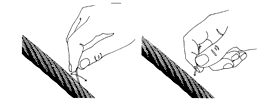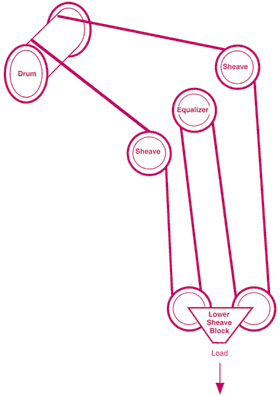General
It is essential to maintain a well planned program of periodic inspections. In most cases there are statutory and/or regulatory agencies whose requirements must be adhered to.
Whether or not such requirements exist in your specific environment, you can be guided by the suggested procedures that follows.
Abrasion, Bending and Crushing represent the ABC‘s of wire rope abuse, and it is the primary goal of good inspection practice to discover such conditions with minimum effort. When any degradation indicates a loss of original rope strength, a decision must be made quickly to allow the rope to remain in service. Such a decision can only be made by an experienced inspector. His determination will be based on:
- Details of the equipment’s operation
- Frequency of inspection
- Maintenance history
- Consequences of failure
- Historical records of similar equipment
Broken Wires
Shortly after installation
The occasional premature failure of a single wire may be found early in the rope life and in most cases it should not constitute a basis for rope removal. Note the area and watch carefully for any further wire breaks. Remove the broken ends by bending the wire backwards and forwards. In this way the wire is more likely to break inside the rope where the ends are left tucked away between the strands. These infrequent premature wire breaks are not caused by fatigue of the wire material.

During wire rope service (Fatigue Breaks)
The rope must be replaced if a certain number of broken wires are found which indicate that the rope has reached its finite fatigue life span.
See Broken Wire Discard Tables.
|
Areas to examine (Based on ISO 4309)
- Examine termination of the rope.
- Examine for defective coiling, which causes deformation (flattened portions) and wear, which can be severe at cross-over positions. (cross-overs only if multiple layer drums).
- Examine for wire breaks.
- Examine for corrosion.
- Look for deformations caused by snatch loading.
- Examine portion which winds over sheave for wire breaks and wear.
- Check section of rope on equalizer sheave (or compensating pulley) by lifting up the rope to look at the underside.
- Look for deformation.
- Check rope diameter against original wire rope diameter. Keep record of rope diameter measured after break in period. Note that shortly after installation rope diameter will slightly decrease.
- Examine carefully length which runs through lower sheave block, particularly that section which is in contact with the pulley when the crane is in a loaded condition.
- Examine for wire breaks or surface wear.
|
 |

